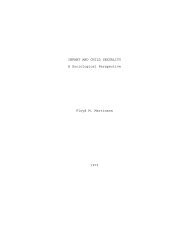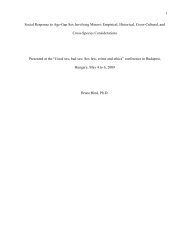Download PDF - Springer
Download PDF - Springer
Download PDF - Springer
You also want an ePaper? Increase the reach of your titles
YUMPU automatically turns print PDFs into web optimized ePapers that Google loves.
334 Ames and Houston<br />
to what constitutes the sexual use of children in a biological sense. Accordingly,<br />
"sociolegal pedophilia" has different dimensions than "oiological pedophilia."<br />
The confusion surrounding the differences between these two conceptualizations<br />
has hindered research into pedophilia, hampering our efforts to understand<br />
this problem. We must distinguish between violations of sociolegal<br />
norms and the more biologically dysfunctional problem of true pedophilia<br />
(i.e., sexually attracted by biologically prepubescent children).<br />
HISTORICAL OVERVIEW<br />
The historical record reveals no universal consensus on the appropriateness<br />
of adult/child sex outside the nuclear family. Nonetheless, while little<br />
recorded history exists pertaining to children, the evidence that does exist<br />
indicates that the sexual use of children has a long history.<br />
The sexual use of pubescent boys was practiced in Ancient Greece where<br />
young males, barely past puberty and as yet "unbearded," were solicited by<br />
warriors as proteges and lovers (Vanggaard, 1972). These boys always took<br />
the passive role, since men who allowed themselves to be sodomized were<br />
held in the lowest contempt (Ungaretti, 1978).<br />
The growth of Christianity led to the condemnation of these practices,<br />
though apparently not to protect the young males as much as to prevent onanism<br />
(Goodrich, 1976). These condemnations served to protect male children<br />
somewhat, but no such protection was afforded female children. Medieval<br />
Canon law officially forbade the marriage of girls less than 12 years old,<br />
but it was not uncommon to find girls of 10 married to very old men (Nobile,<br />
1976). The streets of 14th century Florence were alive with children of both<br />
sexes acting as prostitutes (Goodrich, 1976).<br />
Historical accounts from the 18th century indicate that adult/child sex<br />
(particularly same-sex pairings) were an accepted practice in China, Japan,<br />
Africa, Turkey, Arabia, Egypt, and the Islamic areas of India (Trnmbach,<br />
1977). In 19th century London the going price for a virginal, 12-year-old<br />
girl, of good background, was reported to be 400 pounds (Bullough, 1964).<br />
Two recent "travel guides for gentlemen" show that the desire for sexual<br />
interactions with children is still apparent in the Western world. The Discreet<br />
Gentlemen's Guide to the Pleasures of Europe (1975) reported on where one<br />
can find "Lolita-eyed nymphettes who make pocket money with every orifice<br />
but the natural one." Along the same lines, Mankofj~s Lusty Europe (1973)<br />
revealed where one can find prostitutes as young as 10 years old. The full<br />
scope of such sexual practices is indicated in a report on child pornography<br />
given to the Congress of the United States. This report stated that at least<br />
250 publications exist in the U.S. devoted to the graphic depiction of erotica
















